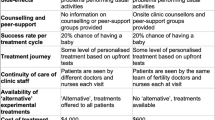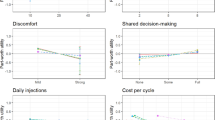Abstract
Background
The contingent valuation (CV) method is an alternative approach to typical health economic methods for valuing interventions that have both health and non-health outcomes. Fertility treatment, such as in vitro fertilisation (IVF), fall into this category because of the significant non-health outcomes associated with having children.
Aim
To estimate the general population’s willingness to pay (WTP) for one cycle of IVF and one year of IVF treatment, and to test the reliability and validity of a CV instrument.
Methods
Three online CV surveys were administered to a total of 1870 participants from the Australian general population using an ex-post perspective, that is, they assumed they were infertile and needed IVF to conceive a child. Participants answered questions with starting point WTP bids of 2018 Australian dollars (AU$) 4000 or $10,000 for the cost of one IVF cycle, and treatment success rates of 10%, 20% and 50% per IVF cycle. Tests for reliability, internal construct validity, starting point bias, and external validity were performed.
Results
Depending on the success rate and the starting point WTP bid, the mean WTP for one IVF cycle ranged from $6135 to $13,561, while the mean WTP for one year of IVF treatment varied from $17,080 to $31,006. The CV method was reliable and satisfied internal construct and external criterion validity. However strong starting point bias was evident, rendering the mean WTP values highly imprecise.
Conclusion
The CV method holds promise for eliciting the value of interventions, such as fertility treatment, that have significant health and non-health outcomes. Survey instruments that prevent starting point bias are essential. Comparing the results of CV methods to other value elicitation methods is needed to confirm convergent validity.
Similar content being viewed by others
Data Availability Statement
The data are not publicly available due to ongoing studies using the data under licence from Survey Sampling International but may be available from the corresponding author on reasonable request.
References
Inhorn MC, Patrizio P. Infertility around the globe: new thinking on gender, reproductive technologies and global movements in the 21st century. Hum Reprod Update. 2015;21(4):411–26.
Mascarenhas MN, et al. National, regional, and global trends in infertility prevalence since 1990: a systematic analysis of 277 health surveys. PLoS Med. 2012;9(12):e1001356.
Dyer S, et al. International Committee for Monitoring Assisted Reproductive Technologies world report: assisted reproductive technology 2008, 2009 and 2010. Hum Reprod. 2016;31(7):1588–609.
Centers for Disease Control and Prevention (CDC), American Society for Reproductive Medicine (ASRM), and Society for Assisted Reproductive Technology (SART). Assisted reproductive technology success rates: national summary and fertility clinic reports. Atlanta: US Dept of Health and Human Services; 2013. p. 2015.
Harris K, et al. Assisted reproduction technology in Australia and New Zealand 2014. Assisted reproduction technology series no. 18. The University of New South Wales. Sydney. 2016.
Chambers GM, et al. Population trends and live birth rates associated with common ART treatment strategies. Hum Reprod. 2016;31(11):2632–41.
Boivin J, et al. International estimates of infertility prevalence and treatment-seeking: potential need and demand for infertility medical care. Hum Reprod. 2007;22(6):1506–12.
Marcus D, et al. Infertility treatment: when is it time to give up? An internet-based survey. Hum Fertil. 2011;14(1):29–34.
Chambers GM, et al. The impact of consumer affordability on access to assisted reproductive technologies and embryo transfer practices: an international analysis. Fertil Steril. 2014;101(1):191–8.
Jones HW Jr, et al. International Federation of Fertility Societies Surveillance 2010: preface. Fertil Steril. 2011;95(2):491.
Chambers GM, et al. The economic impact of assisted reproductive technology: a review of selected developed countries. Fertil Steril. 2009;91(6):2281–94.
IFFS. International Federation of Fertility Societies (IFFS). IFFS surveillance 2010. Fertil Steril. 2011;95(2):491.
Devlin N, Appleby J, Parkin D. Patients’ views of explicit rationing: what are the implications for health service decision-making? J Health Serv Res Policy. 2003;8(3):183–6.
Ryan M. Using conjoint analysis to take account of patient preferences and go beyond health outcomes: an application to in vitro fertilisation. Soc Sci Med. 1999;48(4):535–46.
Fawsitt CG, et al. A cost-benefit analysis of two alternative models of maternity care in Ireland. Appl Health Econ Health Policy. 2017;15(6):785–94.
Kjær T. A review of the discrete choice experiment-with emphasis on its application in health care. Copenhagen: Syddansk Universitet; 2005.
Oerlemans LAG, Chan K-Y, Volschenk J. Willingness to pay for green electricity: a review of the contingent valuation literature and its sources of error. Renew Sustain Energy Rev. 2016;66:875–85.
Venkatachalam L. The contingent valuation method: a review. Environ Impact Assess Rev. 2004;24(1):89–124.
Carson RT, Flores NE, Meade NF. Contingent valuation: controversies and evidence. Environ Resour Econ. 2001;19(2):173–210.
Hausman J. Contingent valuation: from dubious to hopeless. J Econ Perspect. 2012;26(4):43–56.
Zawojska E, Czajkowski M. Re-examining empirical evidence on stated preferences: importance of incentive compatibility. J Environ Econ Policy. 2017;6(4):374–403.
Ryan M. Should government fund assisted reproductive techniques? A study using willingness to pay. Appl Econ. 1997;29(7):841–9.
Maria G, et al. Couples’ willingness to pay for IVF/ET. Acta Obstetr Gynecol Scand. 1995;74(3):199–202.
Mandy R. Using willingness to pay to assess the benefits of assisted reproductive techniques. Health Econ. 1996;5(6):543–58.
Rowe RD, Schulze WD, Breffle WS. A test for payment card biases. J Environ Econ Manag. 1996;31(2):178–85.
Neumann PJ, Johannesson M. The willingness to pay for in vitro fertilization: a pilot study using contingent valuation. Med Care. 1994;1:686–99.
Cummings RG, Harrison GW, Osborne LL. Can the bias of contingent valuation be reduced? Evidence from the laboratory. Economics Working Paper B-95, 1995.
Cummings RG, Taylor LO. Does realism matter in contingent valuation surveys? Land Econ. 1998;74(2):203–15.
Carson R, Groves T, Machina M. Incentive and informational properties of incentive questions. Work. paper, University of California-San Diego. 2000. http://weber.ucsd.edu/-rcarson/. Accessed Feb 2000.
Bjornstad D, Cummings R, Osborne L. A learning design for reducing hypothetical bias in the contingent valuation method. Environ Resour Econ. 1997;10(3):207–21.
Carson RT, et al. Referendum design and contingent valuation: the NOAA panel’s no-vote recommendation. Rev Econ Stat. 1998;80(3):484–7.
Harris K, et al. Assisted reproductive technology in Australia and New Zealand 2014. National Perinatal Epidemiology and Statistics Unit, the University of New South Wales: Sydney, Australia. 2016.
Marino JL, et al. Fertility treatments and the young women who use them: an Australian cohort study. Hum Reprod. 2010;26:deq305.
Herbert DL, Lucke JC, Dobson AJ. Infertility, medical advice and treatment with fertility hormones and/or in vitro fertilisation: a population perspective from the Australian Longitudinal Study on Women’s Health. Aust N Zeal J Public Health. 2009;33(4):358–64.
Australian Bureau of Statistics, Australian National Population Statistics. 2018. http://www.abs.gov.au/AUSSTATS. Accessed 2018.
Mogas J, Riera P, Bennett J. A comparison of contingent valuation and choice modelling with second-order interactions. J For Econ. 2006;12(1):5–30.
Howley P, Hynes S, Campbell D. A choice experiment versus a contingent valuation approach to agri-environmental policy valuation. Working Paper 2011. No. 0173.
Ryan M. A comparison of stated preference methods for estimating monetary values. Health Econ. 2004;13(3):291–6.
Ryan M, Watson V. Comparing welfare estimates from payment card contingent valuation and discrete choice experiments. Health Econ. 2009;18(4):389–401.
van der Marjon P, et al. Convergent validity between a discrete choice experiment and a direct, open-ended method: comparison of preferred attribute levels and willingness to pay estimates. Soc Sci Med. 2008;67(12):2043–50.
Author information
Authors and Affiliations
Contributions
GMC and MS conceived the study. GMC, MS, MZR, SNS, WB designed the study. MZR, SNS and WB analysed the data. All authors contributed to the drafting and revision of the paper.
Corresponding author
Ethics declarations
Funding
This study was funded by the Australian National Health and Medical Research Council (NHMRC), Project Grant APP1104543.
Conflict of interest
Stella Nalukwago Settumba (SNS), Marian Shanahan (MS), Willings Botha (WB), and Muhammad Zulilhaam Ramli (MZR) do not declare any conflicts of interest. Georgina Mary Chambers (GMC) is employed by University of New South Wales (UNSW) and is Director of the National Perinatal Epidemiology and Statistics Unit (NPESU), UNSW. The Fertility Society of Australia funds the NPESU to manage the Australian and New Zealand Assisted Reproduction Database and conduct national reporting of assisted reproductive technology in Australia and New Zealand.
Ethical Approval
This study was approved by the Human Research Ethics Committee, Health and Social Science Panel, University of New South Wales, Sydney. Participants provided consent to participate in the study.
Electronic supplementary material
Below is the link to the electronic supplementary material.
Rights and permissions
About this article
Cite this article
Settumba, S.N., Shanahan, M., Botha, W. et al. Reliability and Validity of the Contingent Valuation Method for Estimating Willingness to Pay: A Case of In Vitro Fertilisation. Appl Health Econ Health Policy 17, 103–110 (2019). https://doi.org/10.1007/s40258-018-0433-3
Published:
Issue Date:
DOI: https://doi.org/10.1007/s40258-018-0433-3




